Congenital Circumferential Constriction Band of the Abdomen: A Case Report
Abstract
We report a case of congenital constriction band of abdomen associated with limb pseudarthrosis. The constriction band around the abdomen, though may cause initial difficulty with ventilation and parental distress, does not interfere with feeding, bowel movements, and growth. It heals spontaneously with supportive treatment though surgery may be needed in some cases.
1. Introduction
Though several hundred cases of congenital constriction band of the limbs have been described, that of abdomen is rare and only ten cases have been reported in the literature.
2. Case Report
A 31-week preterm baby was noted at birth to have a deep circumferential constriction band of the abdomen (Figure 1). There was also a deep constriction ring involving the right leg that resulted in a pseudoarthrosis below knee (Figure 3). The clinical appearance of the abdomen was striking and initially appeared to interfere with breathing requiring ventilation on high pressures, but there were no mechanical problems affecting feeding or neurological pressure symptoms. In the absence of symptoms after the first few weeks, surgical correction using multiple Z-plasties was planned before school age. However, since he presented before that with abdominal pain, surgery was undertaken at 2 years of age (Figures 1 and 2). A transtibial (below knee) amputation was required for functional management of the right leg deformity (Figure 4).
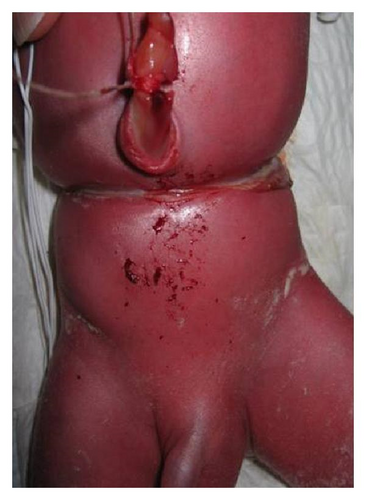
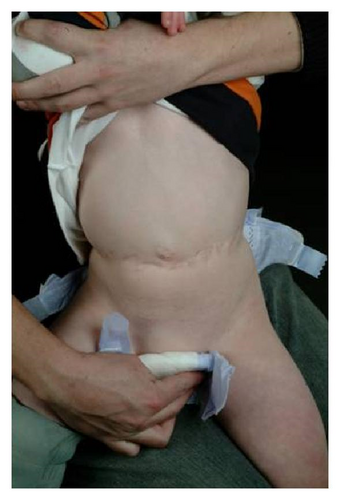
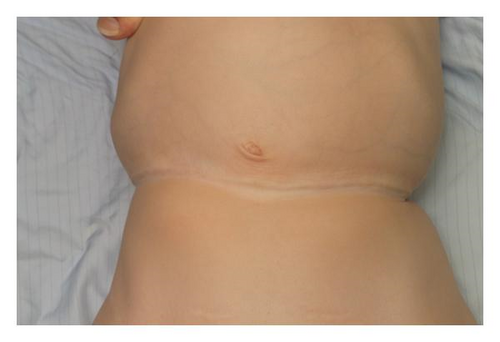
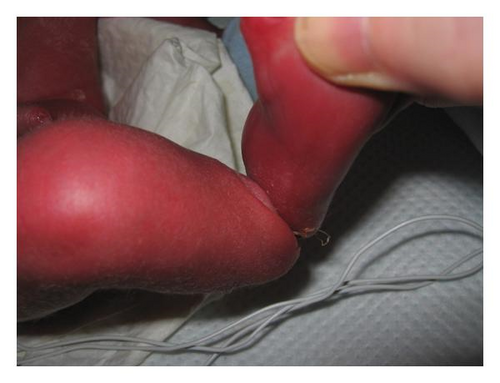
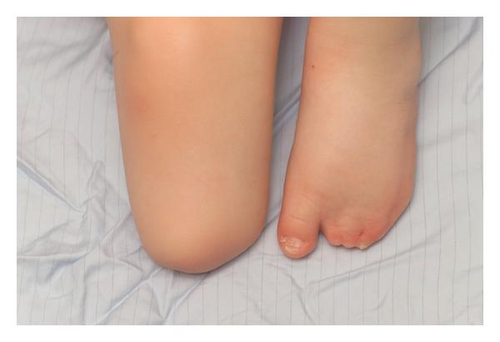
3. Discussion
The overall reported prevalence of amniotic bands in the UK and Western Europe varies between 0.44 to 0.48 (per 10,000 births) [1]. Circumferential congenital constriction band of the abdomen is extremely rare [2–4]. Some common characteristics of the congenital constriction band of the abdomen have been described [5]. The constriction band follows a single segment that is higher on the back. The constriction ring may be located above or below the pelvic brim. The depth varies from a shallow groove to a deep gutter and usually extends only up to the first fascial layer. Histologically, the constriction bands are made of abundance of acellular fibrous tissue, or fibrous tissue containing fibroblasts, covered by squamous cells. This can make them inelastic and can produce a ligature effect. There may or may not be other associated congenital abnormalities.
To the best of our knowledge, only 10 published cases of congenital constriction band involving the abdomen, with or without associated abnormalities, have been described (Table 1).
| Author | Year | Location to pelvic brim | Sex | Other abnormalities |
|---|---|---|---|---|
| Brown et al. | 1957 | below | M | None |
| Schneider et al. | 1976 | below | F | Pilonodal sinus Cleft of soft palate |
| Evans | 1973 | above | F | None |
| Izumi et al. | 1971 | above | M | Band around 2 toes and club foot |
| Casaubon et al. | 1983 | above | F | None |
| Jones | 1986 | above | M | Limb defects |
| Bahadoran et al. | 1997 | above | F | None |
| Lin et al. | 1999 | above | M | None |
| Kim et al. | 2007 | above | F | Ring constriction of the left leg, absent hallux |
| Fawzy et al. | 2008 | below | F | Constriction bands on both calves, congenital amputations of toes |
Despite the alarming appearance, abdominal bands do not seem to cause mechanical problems [3]. Whilst the “hour glass” deformity can improve with time, plastic surgery may still be required as the abdominal contents expand or for cosmesis (Figure 1).




